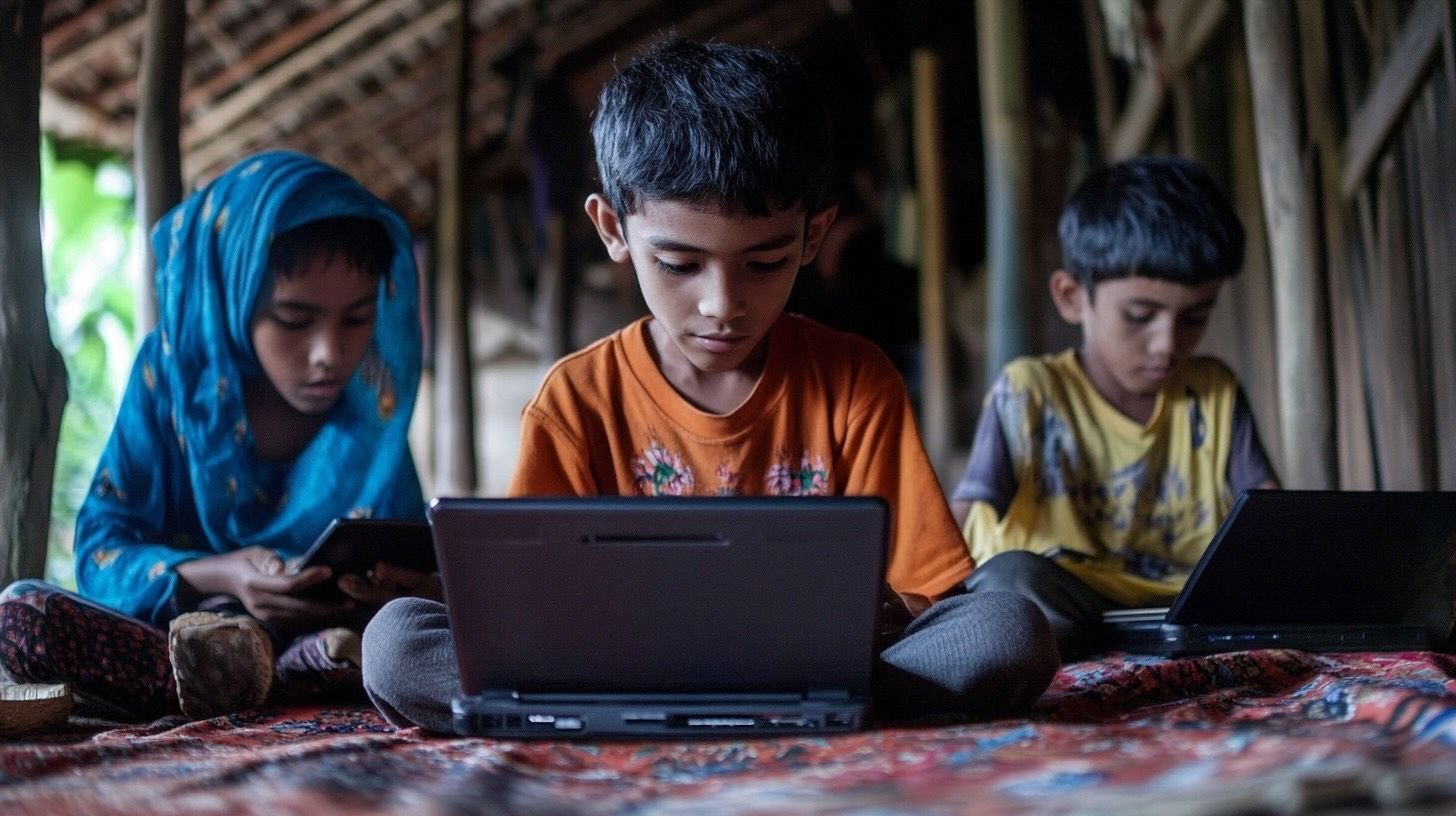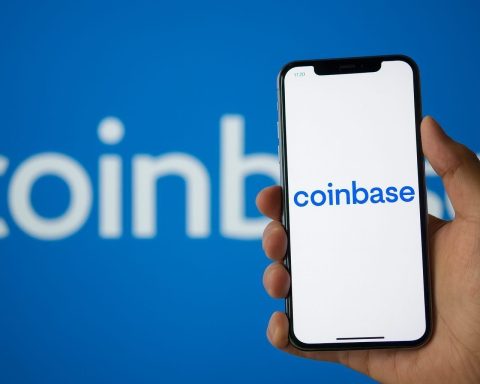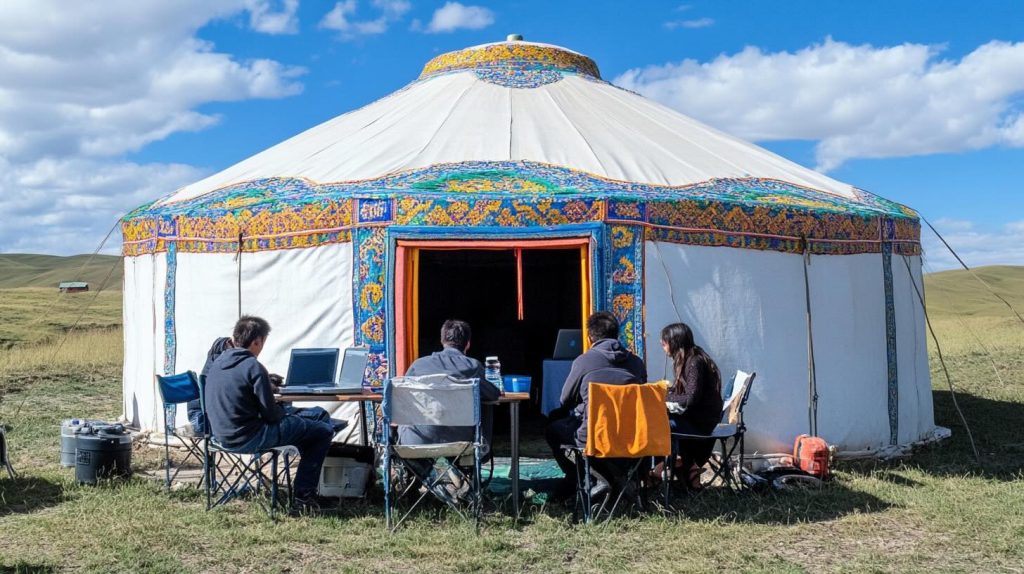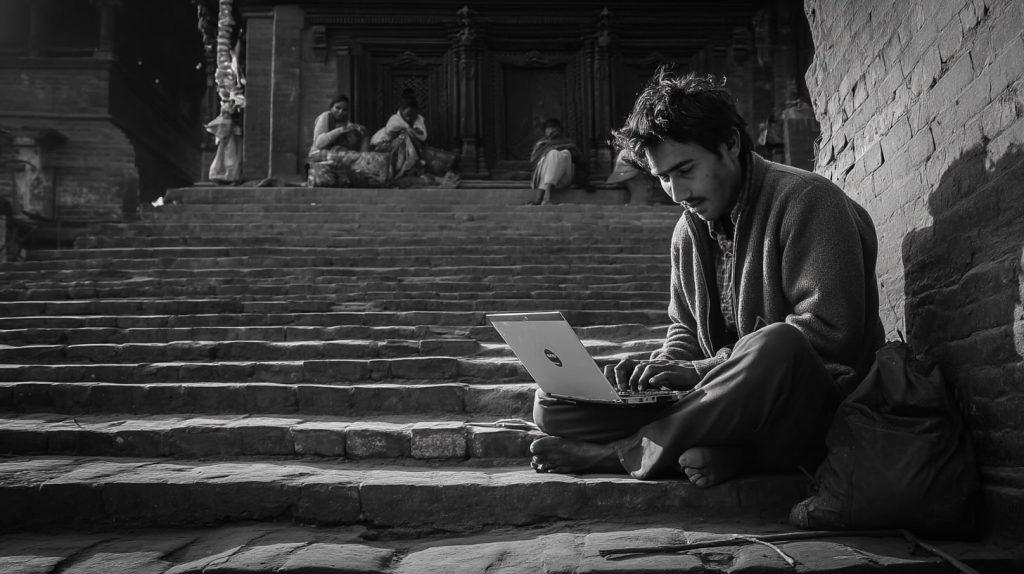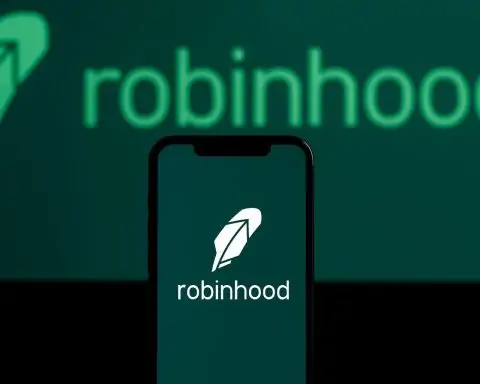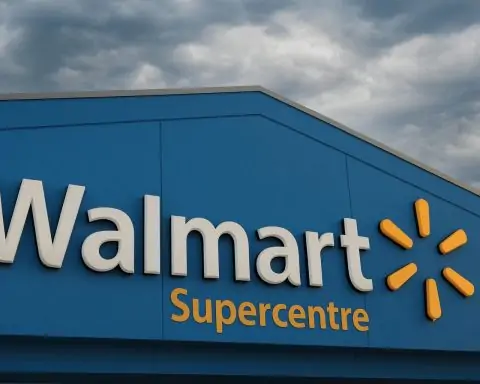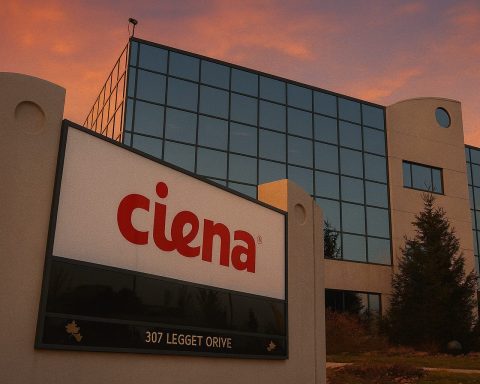- Telkomsel dominates Indonesia’s mobile market with about 45% of subscribers (roughly 153 million) in 2024, and IndiHome now accounts for roughly 75% of fixed broadband after the integration.
- IndiHome fiber-to-the-home footprint has passed 38 million homes, with at least around 10 million connected by mid-2024.
- The Palapa Ring backbone spans over 13,000 km of fiber, linking western, central, and eastern Indonesia to provide high-capacity backhaul beyond Java.
- Internationally, Indonesia is tied to multiple undersea cables, including new trans-Pacific links Project Echo and Bifrost (Meta) that will boost trans-Pacific capacity by about 70%, along with the Apricot cable planned to deliver 190+ Tbps by 2025–2026.
- 3G shutdown has progressed significantly, with Indosat Ooredoo Hutchison completely switching off 3G nationwide by 2022, Telkomsel upgrading all 3G users to 4G by mid-2023, and 2G being phased out.
- 4G coverage now reaches over 97% of Indonesia’s population, with Telkomsel leading in coverage quality and IOH/XL also covering broad areas, though some remote regions remain less served.
- 5G rollout began in 2021 and, by end-2024, covered 26.3% of the population with about 15.7 million 5G connections, while Nusantara received 49 base stations to support 4G/5G.
- SATRIA-1, Indonesia’s high-throughput satellite launched in June 2023, has 150 Gbps capacity and aims to connect around 150,000 public service points including about 93,000 schools and 3,700 clinics.
- Starlink entered Indonesia with a retail license in 2023–2024 and became commercially available by May 2024, with a typical subscription around IDR 750,000 per month and a focus on outer regions and health facilities.
- Urban–rural gaps persist but are narrowing: urban internet penetration is around 82% vs rural 74%, and government programs have delivered 4G BTS in 3T areas totaling 4,988 towers by end-2023 plus Desa Internet initiatives.
Indonesia’s internet landscape is undergoing a rapid transformation, connecting one of the world’s largest archipelagos through a mix of mobile networks, fiber optics, undersea cables, and even satellites. This comprehensive report explores how Indonesia – a nation of 270+ million people spread across 17,000 islands – is closing its digital divide. We’ll examine the major providers dominating the market, the rollout of 4G and 5G across cities and villages, the state of fixed broadband, infrastructure developments (from undersea fiber to remote cell towers), internet speeds and costs, government policies on content, new satellite services like Starlink, the urban-rural gap in access, and the country’s plans to expand connectivity even further.
Major Internet Service Providers and Market Share
Indonesia’s telecom market is served by a handful of large operators after years of consolidation:
- Telkomsel (Telkom Indonesia Group): The dominant player in mobile and broadband. As of 2024, Telkomsel controls about 45% of mobile subscribers [1]– roughly 153 million users – far more than any rival. Telkomsel is partly state-owned (via Telkom Indonesia) and is known for the widest coverage. Uniquely, Telkomsel now also leads in fixed broadband: after integrating Telkom’s IndiHome service, it accounts for three-quarters of all fixed broadband connections in Indonesia [2]. Under the IndiHome brand, Telkomsel offers fiber-to-the-home and DSL, having laid fiber past 38 million homes nationwide [3]. Telkomsel’s mobile arm also offers a home fixed-wireless service branded Orbit [4].
- Indosat Ooredoo Hutchison (IOH): Formed by the 2022 merger of Indosat Ooredoo and Tri (3) Hutchison, IOH is the second-largest mobile operator with around 28% mobile market share [5](about 100 million subscribers). IOH has improved its network by combining infrastructure from the two merged companies. In fixed broadband, IOH is a newer entrant – it launched Indosat HiFi fiber service and even acquired the fiber operator MNC Play’s customers to grow its broadband base [6].
- XL Axiata: The third-largest mobile provider (~16% share [7], ~58 million users). XL has been expanding its services beyond mobile. In 2024, XL Axiata moved to acquire a majority stake in Link Net (which operates the First Media cable internet service) to boost its fixed broadband footprint [8]. Once merged, XL combined with Link Net would become the second-largest fixed broadband ISP after Telkom, allowing XL to offer bundled mobile + home internet services [9].
- Smartfren: A smaller operator (~11% mobile share [10], ~35 million users) that historically focused on CDMA and now 4G LTE. Smartfren does not (yet) offer fixed broadband, but it has niche popularity for affordable data plans. Notably, in late 2024 XL and Smartfren announced a planned merger to create a stronger combined operator [11]– a move aimed at pooling spectrum and infrastructure to better compete.
- Other ISPs: Several private ISPs serve fixed broadband in urban areas. Key ones include Biznet and MyRepublic(fiber providers), CBN (fiber), MNC Play (fiber/cable, part of MNC group), First Media (cable, soon under XL), and Icon+ (a fiber subsidiary of the state electricity company PLN). Among these, Icon+ is currently the second-largest fixed broadband provider with about 7% share of connections [12]. Most offer fiber-to-the-home in major cities, while First Media is unique as a cable internet provider [13]. Overall, however, Telkom’s IndiHome dwarfs all these with its nationwide reach.
Indonesia’s telecom sector has thus consolidated into a few giants dominating both mobile and fixed internet. The top three mobile operators (Telkomsel, IOH, XL) account for nearly 90% of subscriptions [14]. On the fixed side, Telkomsel (IndiHome) is overwhelmingly dominant [15], though upcoming mergers (XL-LinkNet, etc.) promise to shake up market share.
Mobile Internet Coverage and Penetration (3G, 4G, 5G)
Mobile broadband is the primary way Indonesians get online, thanks to extensive 4G networks reaching most populated areas. Key highlights of the mobile landscape:
- Phasing Out 3G: Indonesia has been migrating from 3G to 4G over the past few years. The government initiated a gradual 3G shutdown in early 2022 to free up spectrum for newer technologies [16]. Indosat Ooredoo Hutchison led the charge by becoming the first to completely switch off 3G nationwide [17]. Telkomsel followed suit – by mid-2023 it had upgraded all its 3G users to 4G across 504 cities and regencies [18]. XL Axiata is also in the process of turning off remaining 3G sites and transitioning customers to 4G [19]. As a result, legacy 3G is nearly extinct, and even 2G is being kept only for basic services. This transition has allowed operators to boost 4G capacity and prepare for 5G on those frequencies.
- 4G LTE Coverage: Indonesia has achieved broad 4G population coverage, especially in western and central regions. Telkomsel, with its ubiquitous tower network, claims to cover over 97% of the population with its 4G/LTE signal [20]. Competitors IOH and XL also cover the vast majority of Indonesians, though their coverage in some remote or sparsely populated areas is slightly less comprehensive. By one measure, Telkomsel leads the industry in coverage quality with a Coverage Experience score of 8.9/10, far ahead of rivals [21]. In practical terms, 4G is available in essentially all cities and towns and even many rural villages after aggressive network rollout. Importantly, the government (through programs discussed later) has been building 4G base stations in previously uncovered villages, extending LTE signal to far-flung islands and border regions that never had reliable 3G before.
- Mobile Internet Penetration: With wide 4G availability and affordable data, Indonesia’s internet user base has grown tremendously. As of 2023, 79.5% of the population uses the internet [22]– roughly 221 million users – up from around 70% just a few years ago. Much of this access is via smartphones on cellular data networks. The Indonesian Internet Service Providers Association (APJII) notes that internet penetration rose from 78.1% in 2022 to 79.5% in 2023 [23] [24]. Urban areas have slightly higher usage (82% penetration) compared to rural areas (74%) [25], but the gap is closing. Virtually all of those users are on mobile internet to some extent, given the relative scarcity of fixed lines.
- 5G Rollout: Indonesia is in the early stages of 5G deployment. All three major mobile carriers launched 5G services in 2021, initially in select high-density zones of Jakarta and other large cities. However, 5G coverage remains limited – as of the end of 2024, 5G networks covered only about 26.3% of the population [26]. Carriers have so far been deploying 5G on existing mid-band spectrum (1800 MHz, 2100 MHz, 2300 MHz) in urban hotspots [27], yielding modest coverage footprints. Roughly 15.7 million 5G connections exist (for example, users with 5G-capable phones in coverage) [28]. Telkomsel and Indosat have focused 5G in central business districts, airports, and landmark areas, while XL’s 5G is very limited. One notable expansion is support for the new capital city Nusantara in Borneo – Telkomsel installed 49 base stations there to provide 4G/5G coverage in anticipation of the capital’s relocation [29]. Overall, operators have been cautious in 5G rollout due to the high cost and still-evolving demand – waiting for more spectrum to be allocated and for the device ecosystem to mature. The government is expected to auction new 5G spectrum (e.g. 3.5 GHz and 700 MHz bands) to boost coverage. By 2027, with additional spectrum, 5G is forecasted to cover around 60% of the population (tens of millions of users) [30] [31]. Until then, 4G will remain king, carrying the bulk of data traffic nationwide.
In summary, Indonesia’s mobile networks have rapidly evolved – 3G is essentially gone, 4G LTE blankets most of the country, and 5G is on the horizon but not yet widespread. The vast majority of Indonesians rely on mobile data for their internet needs, thanks to nationwide 4G coverage and ever-cheaper smartphones.
Fixed Broadband: Fiber, DSL, and Wireless Internet
Fixed broadband in Indonesia has historically lagged mobile, but it is now growing steadily, especially in urban centers. Fiber-optic broadband is expanding to more homes, although overall household penetration remains relatively low. Key points about fixed internet:
- Dominance of IndiHome (Telkom): The fixed-line broadband market is overwhelmingly led by IndiHome, a service of Telkom Indonesia (now managed under Telkomsel). IndiHome provides fiber-to-the-home in hundreds of cities and towns, and legacy DSL in some areas. It has a presence in all 34 provinces. With Telkomsel integrating IndiHome, the provider now controls about 75% of all fixed broadband subscriptions in Indonesia [32]. This reflects Telkom’s early start and huge investments in fiber infrastructure. By mid-2024 IndiHome had passed 38 million households and connected at least ~10 million of them [33]. (For perspective, Indonesia has around 65–70 million households, so there is room to grow). Telkom has also leveraged its national backbone and telephone line infrastructure to reach areas where others didn’t, making it the default option in many smaller cities.
- Other Fiber ISPs: A number of private ISPs compete in the fixed broadband segment, primarily in big cities like Jakarta, Surabaya, Medan, etc. Notable players include Biznet (a major fiber provider known for high speeds, popular in Jakarta and Java), First Media (cable and fiber in Jakarta and some cities, under Link Net), MyRepublic(fiber in urban areas), CBN (fiber, now part of XL’s ecosystem via Link Net), MNC Play (fiber in select cities, part of media conglomerate MNC), Oxygen.id (an ISP focusing on apartments/businesses), and Icon+ (which began by leveraging the electric utility’s fiber grid). These players each hold only single-digit market shares. For example, Icon+ is the second-largest ISP with roughly 7% of fixed broadband connections [34]. Biznet, First Media, and MyRepublic each have significant subscriber bases in the hundreds of thousands, especially in Java’s urban clusters. First Media’s cable network (coaxial cable broadband) has a niche as the only cable internet service, serving parts of Greater Jakarta and a few other cities [35].
- Fixed Wireless Access (FWA): Some providers offer fixed wireless broadband as an alternative to wired lines. Telkomsel’s Orbit service uses 4G/5G routers to deliver home internet (useful in areas without fiber). XL and Indosat also market similar 4G-based home internet plans. These FWA offerings have gained traction in suburban and rural areas where laying fiber is not yet economical. They essentially use the mobile network to provide home Wi-Fi. While not as consistent as fiber, FWA helps extend broadband to more users and is quicker to deploy.
- Low Penetration but Growing: Despite growth, fixed broadband penetration remains relatively low compared to other countries. Only around 15–20% of Indonesian households have a fixed broadband subscription (the exact figure varies; one 2023 study ranked Indonesia just 7th in ASEAN for fixed broadband access) [36]. Cost and availability have been barriers – many lower-income households stick to mobile data only. However, the trend is upward: fiber subscriptions are increasing as prices come down and as urban middle-class demand rises for faster, more stable connections (for streaming, gaming, remote work, etc.). The COVID-19 pandemic highlighted the need for home broadband, boosting subscriptions in cities. The government and private sector are investing heavily to expand fiber networks beyond the major metropolitan areas.
- Pricing of Broadband: Fixed broadband is still relatively expensive for the average consumer, which affects uptake. A typical entry-level fiber plan (IndiHome) costs around Rp 280,000 per month for 30 Mbps (≈ $18) [37]. Higher tiers like 100 Mbps cost about Rp 375,000 (~$25) [38]. These prices, while reasonable by global standards, are a significant expense for lower-income families in Indonesia. Competition from providers like Biznet has gradually pushed prices down and increased speeds offered in packages. ISPs also bundle services (e.g. including IPTV or phone) to add value. Meanwhile, the cost of a basic mobile data plan is far cheaper (as discussed below), which is why many Indonesians forego fixed lines entirely. The government recognizes this affordability gap and has encouraged more competition and infrastructure sharing to reduce broadband costs over time.
In summary, fixed broadband in Indonesia is expanding via fiber, with Telkom/IndiHome blanketing the nation and a handful of private ISPs competing in cities. While currently a minority of households subscribe to fixed internet, the number is rising steadily. Improving fiber reach and affordability is a key focus to complement the ubiquitous mobile internet.
Infrastructure Development: Urban vs Rural Connectivity and Undersea Cables
Ensuring internet access across a vast, geographically fragmented country like Indonesia is an enormous infrastructure challenge. Significant developments in recent years have improved both domestic connectivity (linking islands and rural regions) and international connectivity (undersea cables linking Indonesia to the global internet).
- National Fiber Backbone – The Palapa Ring: Indonesia has built a nationwide fiber-optic backbone known as the Palapa Ring, completed in 2019. This network of undersea and terrestrial fiber cables connects the major islands and many remote regencies to the internet backbone. The Palapa Ring consists of over 13,000 km of fiber divided into western, central, and eastern segments, effectively creating a “digital toll road” across the archipelago. Thanks to this backbone, cities outside Java (like those in Sulawesi, Kalimantan, Maluku, Papua, etc.) now have high-capacity links to the core network. The result is more equal connectivity – it’s no longer only Jakarta or Surabaya that have good backhaul; smaller cities in eastern Indonesia can also enjoy fiber backhaul (enabling faster local mobile and broadband service). The Palapa Ring has dramatically reduced reliance on expensive satellite links for inter-island connectivity. It underpins the ability of operators to extend 4G and fiber to far-flung areas, since those base stations and local networks can backhaul data via fiber instead of slower microwave or satellite.
- Undersea Cable Systems: Internationally, Indonesia is connected by numerous submarine fiber-optic cables to the rest of the world. The primary gateway has traditionally been via Singapore – many cables run between Indonesia (landing in Batam, Jakarta, etc.) and Singapore, which is a regional internet hub. Major existing cables include SEA-ME-WE 5, APCN2, the Indonesia Global Gateway (Jakarta-Singapore) and others that link to hubs in Asia and beyond. However, Indonesia has sought to diversify its international links. Notably, new trans-Pacific cables are in progress that land directly in Indonesia. Project Echo and Bifrost – two subsea cable systems announced by Meta (Facebook) and partners – will directly connect Indonesia to North America (via Java Sea, through Indonesia to Singapore and across the Pacific) [39]. These will be the first trans-Pacific cables through a new route crossing the Java Sea, increasing overall trans-Pacific internet capacity by an estimated 70% [40]. In addition, the Apricot cable (led by Google and Meta) is planned to connect Indonesia with Japan, Taiwan, Guam, the Philippines, and Singapore by 2025–2026, bringing 190+ Tbps of capacity. All these undersea cables bolster Indonesia’s international bandwidth and redundancy – reducing the risk of outages from any single cable cut and lowering latency to key markets.
- Domestic Towers and Fiber in Rural Areas: Within Indonesia, infrastructure disparity between urban and rural areas has long been an issue. Urban centers (especially on Java) enjoy dense networks of cell towers, fiber loops, and data centers. In contrast, many rural villages in outer islands historically had no fiber and sometimes no cellular signal at all. The government has tackled this by funding rural telecommunications infrastructure. A massive project was the construction of thousands of 4G base transceiver stations (BTS) in under-served villages. By the end of 2023, the Ministry of Communication and Informatics (Kominfo) through its agency BAKTI had built 4,988 new 4G towers in “3T” regions (the frontier, outermost, and least developed areas) [41] [42]. In Phase 1, 1,682 remote BTS were built and live by 2020, and Phase 2 added another 4,990 towers on air by late 2023 [43]. These towers bring mobile broadband to villages in places like Papua, Maluku, Nusa Tenggara and other previously disconnected areas. Around 76% of the new BTS were in Eastern Indonesia [44]. Additionally, operators have laid more fiber to cell sites and regional towns as part of network expansion and the Palapa Ring integration. The result is that even many rural areas now have at least a 4G signal (if not fiber to the home). According to APJII, rural internet penetration has climbed to 74% – not far behind urban areas at 82% [45], indicating progress in closing the infrastructure gap.
- New Capital and Smart Cities: Indonesia’s plan to develop a new capital city, Nusantara in East Kalimantan, includes building state-of-the-art digital infrastructure from scratch. Telcos have already deployed 4G/5G coverage there [46]. The government’s “100 Smart Cities” initiative is pushing fiber, public Wi-Fi, IoT networks, and smart city tech in dozens of cities across the country [47] [48]. This will further drive infrastructure upgrades both in big metros and smaller regional capitals.
In essence, Indonesia’s internet infrastructure has seen huge investments in both backbone and last-mile connectivity. Undersea cables (global and domestic) secure the data highways between islands and to other continents, while on the ground thousands of towers and fiber links are bringing broadband to places that once were blank spots on the map. The challenge of connecting an archipelago is being met with a combination of fiber-optic ambition and creative wireless solutions.
Internet Speeds and Pricing (Mobile vs Broadband)
The quality and cost of internet service in Indonesia have improved, though they still trail some regional peers. Here’s a look at typical speeds users experience and how much they pay:
- Mobile Speeds: Mobile data speeds in Indonesia are moderate by global standards. According to Ookla’s Speedtest Global Index, as of early 2025 Indonesia’s median mobile download speed was around 39.5 Mbps(placing it 85th in the world) [49]. Upload on mobile was about 15 Mbps median [50]. This is a big improvement from just a few years ago, thanks to 4G network upgrades. In practice, speeds vary widely – in 4G coverage areas, users might typically get 10–30 Mbps on 4G, while in 5G zones they can exceed 50–100 Mbps. Telkomsel was recorded as the fastest mobile network with a median download ~31.9 Mbps in H1 2024 tests [51]. Still, Indonesia’s mobile speeds rank relatively low in Southeast Asia (it has been cited as one of the slowest in the region historically [52]), due in part to high network load (many users per cell site) and limited spectrum. Latency on mobile averages around 20-30 ms [53], a bit higher in remote areas. As 5G expands and more spectrum is allocated, speeds are expected to climb. Notably, data usage is soaring – the average mobile user consumes ~15 GB per month in 2024, forecast to reach 41 GB by 2030 [54]as streaming and apps proliferate on faster networks.
- Fixed Broadband Speeds: Fixed broadband delivers higher speeds than mobile, though often not as high as in some developed markets. Speedtest rankings show Indonesia’s fixed broadband median download around 32.4 Mbps (rank ~121st globally as of early 2025) [55]. Urban fiber users commonly subscribe to plans of 20–100 Mbps. In Jakarta, many providers offer gigabit plans, but uptake is limited and expensive. For most people on IndiHome or Biznet, real-world speeds of tens of Mbps are the norm – sufficient for HD streaming and video calls, but sometimes struggling with 4K streaming or large downloads. Upload speeds on fixed lines median about 21 Mbps [56], which is decent for consumer needs. It’s worth noting that Indonesia’s average broadband speeds have been climbing year over year. The entry-level plans of 10 Mbps a few years ago have been replaced by 20–30 Mbps as the new baseline. In 2024, Ookla awarded Telkomsel’s IndiHome as having the fastest fixed broadband network in Indonesia, highlighting these improvements [57]. That said, fixed broadband quality can vary; outside major cities the infrastructure may still rely on older copper or wireless links, yielding lower speeds.
- Mobile Data Pricing: One of Indonesia’s strengths is very affordable mobile data. The country consistently ranks among those with the cheapest cost per GB. In 2023, 1 GB of mobile data cost on average only about $0.28 (USD) [58]. This low price is a result of intense competition among telcos for market share and the prevalence of prepaid data bundles. Operators routinely offer large data packages (e.g. 10–30 GB) for just a few dollars, making mobile internet accessible to even low-income users. In fact, a study by Cable.co.uk ranked Indonesia 17th cheapest in the world for mobile data tariffs in 2023. This affordability has driven the mobile internet boom – people can watch YouTube or use social media extensively without prohibitive costs. However, the flip side is that the low ARPU (average revenue per user) puts financial pressure on operators, potentially affecting network investment.
- Fixed Broadband Pricing: As mentioned, fixed broadband is much pricier than mobile on a per-GB or per-month basis. A basic fiber plan costs roughly Rp 300,000 (~$20) per month for speeds of 20–30 Mbps [59]. Higher speed plans (100 Mbps and above) range from Rp 400k–800k ($25-$50+) per month depending on provider and region. These prices mean that fixed broadband can take up a sizable portion of a family’s income, especially outside the wealthier urban households. The ITU’s affordability data shows fixed broadband in Indonesia is mid-ranked in ASEAN in terms of affordability [60]– not the cheapest, not the most expensive. ISPs have been introducing slightly lower-cost options (for example, promotional packs around Rp 200k for a bare-bones service) to entice more users. Additionally, there are community initiatives and government-subsidized programs that provide free or cheap internet at village halls, schools, etc., to improve access (covered in the Digital Divide section below). Over time, as infrastructure costs amortize and competition grows, the hope is that fixed broadband pricing will decline closer to mobile data levels (per GB), but for now many Indonesians rely on mobile data purely because of the price gap.
To summarize, Indonesia’s internet speeds are improving steadily – mobile averaging tens of Mbps and fixed broadband a bit higher – but they are not yet at parity with tech-leading nations. On the bright side, mobile internet is very cheap, fueling widespread use, whereas fixed broadband remains relatively expensive and thus less adopted. Ongoing upgrades in 4G/5G and fiber should continue to push speeds up and costs per bit down.
Government Regulations and Content Restrictions
The Indonesian government plays an active role in regulating internet services, both in terms of industry rules and online content control. Some key aspects of the regulatory and censorship environment include:
- Platform Registration and Intermediary Liability: In 2020, the government issued Ministerial Regulation No. 5 (MR5/2020), one of the strictest content moderation laws in the region [61]. It requires all digital platforms and internet services (social media, messaging, etc.) to register with the government and comply with takedown requests for prohibited content, or face blocking. In mid-2022, authorities temporarily blocked major platforms – including PayPal, Yahoo, and the gaming platform Steam – for a few days when they missed the registration deadline [62]. These sites were unblocked after they complied with MR5’s requirements [63]. The regulation also mandates companies to remove “negative” content (very broadly defined) within 24 hours of notice, or as quick as 4 hours for urgent requests, or face penalties [64]. This has effectively coerced platforms like Google, Meta, TikTok, etc., to more aggressively police content in Indonesia.
- Content Filtering and Censorship: Indonesia maintains a centralized system to block websites and contentdeemed illegal or harmful. The Ministry of Communication and Informatics (Kominfo) regularly orders ISPs to block access to sites related to pornography, gambling, hate speech, terrorism, piracy, and other material contrary to “national norms” or law. The definition of “negative content” is quite broad – encompassing anything from defamation of public figures, blasphemy, to LGBTQ content (which faces restriction under “moral norms”). In 2023 alone, Kominfo ordered the blocking of 791,540 web pages for various violations [65]. About 1,098 of those were flagged for things like defamation or morality issues by government agencies [66], while others were for fraud, radicalism, etc. High-profile examples include the blocking of Reddit and Vimeo in the past (for adult content), and briefly blocking the domain X.com in 2023 when Elon Musk rebranded Twitter to “X” – the domain was initially flagged for possible pornographic content until Twitter clarified the situation [67]. The government has also threatened to block Twitter (X) entirely if it allows pornographic material under its new policies [68]. Websites promoting separatism or extremist ideologies (e.g. some Papua independence sites, extremist religious groups) have been consistently banned. Internet Service Providers must implement these blocks, and in 2022 Kominfo began using a national DNS filtering system with deep packet inspection on mobile networks to more effectively censor prohibited sites [69].
- “Internet Positif” and Apps: Indonesia’s filtering initiative is sometimes dubbed “Internet Sehat” or “Internet Positif” (Positive Internet) – essentially a state-sanctioned clean internet program. Users trying to access blocked sites are often redirected to a warning page. In addition to websites, the government can order app stores to take down applications that facilitate prohibited content (for instance, certain VPN apps or apps used for gambling have been removed). The enforcement can be patchy – savvy users use VPNs to circumvent blocks, but the government has periodically considered banning VPN usage too.
- Privacy and SIM Registration: Since 2018, all prepaid SIM card users must register their SIM with their national ID number (NIK) and family card number. This policy was introduced to reduce spam and fraud, but it also means mobile internet usage is tied to identity [70]. In 2022, Indonesia passed a Personal Data Protection Law (PDPL), akin to GDPR, to regulate how companies handle user data – Kominfo is developing implementing regulations for it [71]. Enforcement of data privacy is still nascent.
- Media and Speech Laws: Indonesia has an Electronic Information and Transactions Law (UU ITE) which has broad provisions criminalizing online defamation and “inciting information.” This law has been used to prosecute social media users, journalists, and activists for online posts. As such, there is a climate of caution – free speech online is curtailed by the threat of legal action for content that in other countries might be considered protected speech. The government has also pushed regulations requiring platforms to prioritize “positive” content and suppress false news or hoaxes, especially in the lead-up to elections [72]. A 2024 decree even requires digital platforms to take down content that undermines “quality journalism” (an attempt to fight fake news by favoring verified news sources) [73].
Overall, Indonesia’s internet is classified as “Partly Free” by watchdogs like Freedom House. The government’s firm hand is evident in both industry structure (Kominfo heavily regulates telecom licenses and spectrum) and content oversight (extensive web blocking and content takedown regimes). While these policies are often justified by authorities in terms of protecting the public from harmful content and maintaining order, critics argue they sometimes veer into overreach and censorship of legitimate expression. Nevertheless, any company operating online in Indonesia must navigate these rules – recent experience shows the government is willing to block even popular services if they don’t comply.
Satellite Internet: Starlink and Other Initiatives
Given Indonesia’s challenging geography, satellite internet plays a crucial role in connecting remote areas where terrestrial infrastructure is lacking. Recent developments have made satellite broadband an exciting frontier:
- Starlink’s Arrival: In 2023-2024, SpaceX’s Starlink low-earth orbit (LEO) satellite service officially entered the Indonesian market. The government granted Starlink a license to operate as an internet provider for retail consumers, after initially limiting it to corporate and government use [74]. By May 2024, Starlink became available commercially in Indonesia [75], making it the third Southeast Asian country (after the Philippines and Malaysia) to approve Starlink [76]. Elon Musk personally visited Bali in May 2024 to launch Starlink for Indonesia’s health sector, demonstrating its use connecting rural clinics [77] [78]. Starlink’s satellite terminals have been deployed to remote community health centers – e.g. in Papua’s Aru Islands – to enable telemedicine and data links where no fiber or 4G exists [79] [80]. The government stated that while Starlink is now open to general customers, initially they are focusing its use on outer and underdeveloped regions that lack connectivity [81]. Early reports indicate Starlink can deliver high-speed internet (100+ Mbps) even in rural Indonesian villages, albeit at a cost: roughly IDR 750,000 per month (around $47) for the subscription, which is about double the average local internet bill [82]. There’s also hardware costs for the satellite dish. This pricing means Starlink is currently targeted at businesses, government offices, or community use more than individual households. Still, for many isolated islands and highlands, Starlink offers a leap forward where previously only patchy VSAT or 2G existed. Kominfo is coordinating with Starlink to ensure compliance with regulations and that it complements (not undermines) local telecom providers [83].
- Domestic Satellites (SATRIA-1 and beyond): Indonesia has launched its own advanced satellites to bridge the connectivity gap. In June 2023, the government’s SATRIA-1 (Satelit Republik Indonesia) was launched via SpaceX Falcon 9 [84]. SATRIA-1 is a high-throughput geostationary satellite with a capacity of 150 Gbps – one of Asia’s largest internet satellites [85]. It reached orbit in late 2023 and began tests, with full operation expected by early 2024 [86]. The goal of SATRIA-1 is to provide high-speed internet to around 150,000 public service points across the archipelago [87]. This includes tens of thousands of schools, hospitals, village offices, and other government facilities in 3T regions (frontier, outermost, remote areas) that are out of reach of fiber [88]. Essentially, SATRIA-1 beams internet via VSAT terminals to these sites, bringing e-learning, e-health and e-government services online [89] [90]. By connecting ~93,000 schools and ~3,700 clinics, among others [91], the satellite is a major plank in Indonesia’s digital inclusion strategy. The project is run by a public-private consortium led by PSN (Pasifik Satelit Nusantara) in cooperation with the government’s BAKTI agency [92]. Looking ahead, Indonesia plans SATRIA-2 and 3 satellites to further boost capacity.
- Other Satellite Options: Even before Starlink and SATRIA, Indonesia has long used satellites for telecom. Legacy geostationary satellites like Telkom-2/3S and Palapa series provided telephone and internet trunking to remote areas. VSAT (very small aperture terminal) installations are common in villages, banks, ATMs, and military posts where terrestrial links aren’t available. Operators like Telkomsat and Lintasarta offer enterprise satellite internet. Additionally, international satellite operators (Inmarsat, Viasat, etc.) serve Indonesia. One notable initiative is by BAKTI providing free Wi-Fi hotspots via satellite to thousands of remote villages – by 2023, satellite-based internet was live in 14,546 locations through such programs [93]. These typically use traditional GEO satellites and offer modest speeds (a few Mbps) shared as community Wi-Fi, but it’s better than nothing for those communities.
- Regulatory Stance: The government welcomes satellite solutions as a complement to ground networks. However, they also enforce rules to protect national interests – for example, initially Starlink was only allowed through a local partner (BAKTI) to serve certain remote needs, to avoid disrupting local ISP businesses. Now with Starlink retail approval, Indonesia will monitor its impact. There is also a focus on using satellites for specific needs like disaster recovery, given Indonesia’s frequent natural disasters that can cut off communications – having satellite backup ensures connectivity when earthquakes or floods damage ground infrastructure.
In summary, satellite internet is turning from a last-resort to a strategic solution in Indonesia’s connectivity mix. With LEO constellations like Starlink bringing unprecedented speed to the remotest islands, and government-backed satellites connecting public facilities, the sky is literally not the limit. These efforts will ensure even the hardest-to-reach parts of Indonesia can join the online world, supporting the country’s goal of equal digital access.
Digital Divide: Urban vs Rural Access and Inclusion Initiatives
Bridging the digital divide between Indonesia’s urban centers and its rural, remote communities has been a central focus in recent years. The divide manifests in terms of availability, affordability, and digital literacy. Here’s how the country is addressing it:
- Current Urban-Rural Gap: Urban Indonesians (in cities like Jakarta, Bandung, Surabaya, Medan, etc.) generally enjoy good internet options – multiple 4G networks, fiber broadband choices, and plentiful Wi-Fi hotspots. In contrast, people in rural villages or outer islands often have fewer options – perhaps a single mobile operator with 4G or 3G coverage, and no fixed line internet at all. This gap is reflected in usage statistics: as per APJII’s survey, internet penetration is ~82.2% in urban areas vs 74.0% in rural areas [94]. While that difference might not seem huge (rural penetration 74% is surprisingly high), it likely reflects basic mobile usage. In terms of quality, urban users tend to get faster speeds and unlimited data, whereas rural users might deal with slower speeds or data caps. Additionally, digital literacy and usage patterns differ – urban users are more likely to utilize e-commerce, online banking, and advanced services, whereas rural users may stick to more basic social media and messaging.
- Infrastructure Initiatives for Rural Areas: As discussed under Infrastructure, the government through BAKTI Kominfo has rolled out programs specifically targeting under-served regions. The flagship is the construction of 4G BTS in 3T regions – nearly 7,000 new cell sites in villages that lacked any signal [95] [96]. These towers are often solar-powered and connect back via satellite or long-distance microwave if fiber isn’t nearby. By lighting up these villages with 4G, millions of people are getting online for the first time. Another major initiative is the “Desa Internet” (Internet Village) program, which establishes community internet access points. For example, many village offices, schools, and clinics have been given satellite or radio links and Wi-Fi routers to provide locals with free or cheap internet access. The SATRIA-1 satellite, as noted, will connect 150k such public spots – many of which are in rural/remote areas – essentially creating community Wi-Fi hotspots for residents who cannot afford personal connections [97]. The Universal Service Obligation (USO) fund (managed by BAKTI) finances these projects, ensuring telecom operators contribute to rural connectivity. There is also the “Palapa Ring Integration” effort – leveraging the national fiber backbone to ensure that once a fiber node reaches a district town, it can be extended via microwave or fiber spurs to surrounding villages, progressively improving backhaul in rural networks.
- Affordability and Subsidies: Affordability is a significant aspect of the digital divide. Even if 4G reaches a village, some residents may find data packages or devices too costly. To tackle this, the government and various NGOs have run digital inclusion programs. During the COVID-19 pandemic, for instance, the government provided subsidized data packages for students and teachers nationwide so they could participate in online schooling. In remote regions, free Wi-Fi centers let people access government services or educational content without using mobile data. There are also discussions about providing device subsidies or financing to help rural folks get smartphones or computers. On the private side, telcos often offer special low-cost plans in certain areas (sometimes branded as “Internet Rakyat” or people’s internet) with cheaper rates, to encourage uptake among lower-income users. The gender gap is also narrowing – interestingly, APJII found female internet penetration (85.5%) is slightly higher than male (77.6%) by 2023 [98], suggesting inclusion efforts are reaching both men and women.
- Education and Literacy: Beyond infrastructure, a softer barrier is digital literacy – knowing how to use the internet productively. There are ongoing initiatives to train rural communities on using digital tools (for agriculture, marketing crafts, accessing telehealth, etc.). The government’s “Literasi Digital” campaigns aim to teach safe and effective internet usage across all provinces. Tech companies like Google and Meta have also run workshops in Indonesia on topics like basic coding, online safety, and small business digital skills, often focusing on women and youth outside big cities.
- Outcomes: Thanks to these efforts, the digital divide has been gradually shrinking. Virtually every village in Java and Bali now has cellular coverage, and the majority even in outer provinces have some internet access. The difference now is more about quality and usage depth rather than a binary have/have-not of connectivity. A farmer in rural Sumatra might have a 4G smartphone and WhatsApp, but may not yet fully partake in e-commerce or e-learning like his urban counterparts. However, as infrastructure continues to improve (and younger, tech-savvy generations grow up in those villages), the gap is expected to diminish. Indonesia’s leadership often cites digital inclusion as critical for equitable economic growth – ensuring that people from Aceh to Papua can equally tap into e-government services, online education, and digital markets.
In summary, Indonesia recognizes that its digital economy can’t thrive only in the cities; it must uplift its villages too. Through a combination of building towers, launching satellites, subsidizing access, and educating users, the country is working to ensure the “internet revolution” benefits all Indonesians, not just those in Jakarta. The journey isn’t complete, but the progress in connecting rural Indonesia in the past 5 years has been remarkable.
Future Trends and Government Plans for Expanding Connectivity
Looking ahead, Indonesia’s internet landscape is poised for further dramatic growth and change. Several future trends and plans will shape the next chapter of Indonesia’s connectivity story:
- Telco Consolidation and Convergence: The telecom industry may see fewer, stronger players. The planned merger of XL Axiata and Smartfren (announced December 2024) is expected to be completed in 2025, pending final approvals [99]. This would consolidate the mobile market into three major operators (Telkomsel, Indosat, and the new XL+Smartfren entity) with more equal footing. A more consolidated market could mean more efficient investments – for example, the merged XL/Smartfren would have larger spectrum holdings and subscriber base to fund network expansion (including 5G) and might aggressively challenge Indosat for the #2 spot. We also may see fixed-mobile convergence intensify: Telkomsel already offers bundled mobile + IndiHome fiber plans; XL will do the same with Link Net’s network; Indosat might partner or acquire to get a fiber arm. This means consumers could get more “one-stop” service offerings and potentially better deals for combined services.
- 5G Expansion and 6G on the Horizon: 5G rollout in Indonesia will accelerate in the coming years. The government has outlined a roadmap for allocating more spectrum for 5G. Key will be the auction of 700 MHz (the “digital dividend” from analog TV shutdown) and 3.5 GHz mid-band frequencies – these are ideal for wide 5G coverage and high capacity. Once those bands are released (expected by 2025–2026), operators can significantly broaden 5G coverage beyond just city centers. By some projections, 5G subscriptions could reach ~70 million by 2027, with networks covering over half the population [100]. Telcos are also exploring 5G Standalone (SA) networks to enable advanced use-cases (low-latency applications, IoT). In fact, Telkomsel launched the first 5G SA network trial in late 2023 [101]. Looking further ahead, Indonesia doesn’t want to lag in future technologies – research on 6G and next-gen network innovation is likely to be on the agenda by the late 2020s, in line with global developments. The “Making Indonesia 4.0” roadmap explicitly includes goals of staying at the forefront of telecom tech [102].
- Fiber Network Growth: The expansion of fiber-optic infrastructure will continue at pace. Telkom/IndiHome will push fiber deeper into second-tier cities and semi-urban areas, replacing remaining copper DSL lines. Other providers like Biznet have plans to enter new cities and even smaller towns, often riding on the back of the Palapa Ring backbone. The government might incentivize fiber builds in areas that are commercially marginal, possibly via public-private partnerships. There is also a plan to build a national data center in the new capital Nusantara and regional data centers – this requires robust fiber connectivity between regions [103] [104]. Moreover, Indonesia is encouraging the development of internet exchange points (IXPs) across the country to localize traffic, which again ties into fiber interconnection growth.
- Satellites and Alternative Tech: On the satellite front, SATRIA-1 will be fully operational through the late 2020s, and plans for SATRIA-2 are underway to add even more capacity. Private companies like PSN are also launching new satellites (e.g., Nusantara Lima, etc.) to expand broadband coverage. By having both LEO (Starlink) and GEO (SATRIA) systems, Indonesia ensures redundancy and multi-layer connectivity for remote areas. Another interesting development could be High-Altitude Platform Stations (HAPS) or stratospheric balloons/drones (like Alphabet’s Loon project, which actually did a pilot in Indonesia years ago). While Loon was discontinued, similar concepts might resurface to fill coverage gaps without requiring full satellite launches.
- Regulatory Evolution: The government will likely refine regulations to balance growth and control. We might see an update or replacement of the controversial MR5 regulation to address criticisms, especially as Indonesia positions itself as a digital economy hub (it wants to attract foreign investment, which requires a conducive regulatory environment). The Personal Data Protection law implementation in 2024–25 will bring new rules for companies on data handling, potentially boosting user trust in online services. There’s also a drive to improve cybersecurity – establishing a stronger national CERT and enforcing standards, given rising cyber threats as more people come online [105]. In terms of market liberalization, the government has gradually opened up more to foreign investment (for example, allowing foreign stakes in data centers and e-commerce), which could help fund connectivity projects.
- Digital Economy Push: Indonesia is on track to have one of the largest digital economies in Southeast Asia, projected over $130 billion by 2025 [106]. To support this, connectivity must keep up. The government’s Digital Indonesia Roadmap 2021-2024 lays out goals such as expanding 4G/5G to all regions, improving digital skills, and integrating tech into sectors like agriculture and education [107]. Beyond 2024, a new roadmap will likely extend these goals. Specific programs include continuing the Smart City program, boosting fintech and e-commerce penetration (which rely on good internet), and developing the tech startup ecosystem across the country, not just in Jakarta. All these require robust internet infrastructure everywhere.
- New Capital as a Showcase: Nusantara, the upcoming capital city, is envisioned as a “smart, green, connected” city built from the ground up with the latest tech. This will likely be a showcase for things like city-wide 5G, extensive public Wi-Fi, IoT sensors, autonomous vehicles, and so forth. If realized, it could spur similar upgrades in other cities and prove out use cases for advanced connectivity (like smart traffic systems, telepresence government services, etc.). The success of Nusantara’s digital infrastructure could accelerate adoption of next-gen connectivity solutions nationwide.
In conclusion, Indonesia’s internet journey is far from over – in fact, it’s poised to leap into an even more connected future. We can expect faster networks (5G and beyond), more ubiquitous fiber, and innovative solutions to connect the last pockets of the archipelago. The government’s strong commitment – as seen in projects from Palapa Ring to SATRIA satellites – will continue, driven by the understanding that digital connectivity is the backbone of economic growth and social inclusion. Indonesia’s unique story, moving from “island hopping to web surfing,” shows how a vast developing nation can rapidly modernize its internet landscape. The coming years will solidify its transformation into a truly digital archipelago, where even the most isolated islander can be just as connected as a Jakarta city dweller, and where the internet becomes an equalizing force tying the nation together.
Sources: The information in this report is supported by data and analysis from government agencies, industry reports, and news sources, including APJII’s 2024 survey on internet users [108] [109], OpenSignal and GSMA reports on network experience and market share [110] [111] [112], Freedom House’s Freedom on the Net report [113] [114], Reuters and local news on Starlink’s launch [115] [116], and official Telkom/Telkomsel releases on network coverage and speeds [117], among others. These sources are cited throughout the text to provide detailed, up-to-date evidence of Indonesia’s internet development trajectory.
References
1. www.gsma.com, 2. www.opensignal.com, 3. www.opensignal.com, 4. www.opensignal.com, 5. www.gsma.com, 6. www.opensignal.com, 7. www.gsma.com, 8. www.opensignal.com, 9. www.opensignal.com, 10. www.gsma.com, 11. www.gsma.com, 12. www.opensignal.com, 13. www.opensignal.com, 14. www.globenewswire.com, 15. www.opensignal.com, 16. www.opensignal.com, 17. www.opensignal.com, 18. www.opensignal.com, 19. www.opensignal.com, 20. www.telkomsel.com, 21. www.opensignal.com, 22. heaptalk.com, 23. heaptalk.com, 24. www.mordorintelligence.com, 25. heaptalk.com, 26. www.gsma.com, 27. www.gsma.com, 28. www.gsma.com, 29. www.datacenterdynamics.com, 30. www.gsma.com, 31. www.gsma.com, 32. www.opensignal.com, 33. www.opensignal.com, 34. www.opensignal.com, 35. www.opensignal.com, 36. www.gsma.com, 37. www.telkomsel.com, 38. www.telkomsel.com, 39. engineering.fb.com, 40. engineering.fb.com, 41. heaptalk.com, 42. heaptalk.com, 43. heaptalk.com, 44. heaptalk.com, 45. heaptalk.com, 46. www.datacenterdynamics.com, 47. www.trade.gov, 48. www.trade.gov, 49. www.speedtest.net, 50. www.speedtest.net, 51. www.ookla.com, 52. www.facebook.com, 53. www.speedtest.net, 54. www.gsma.com, 55. www.speedtest.net, 56. www.speedtest.net, 57. www.telkomsel.com, 58. prepaid-data-sim-card.fandom.com, 59. www.telkomsel.com, 60. www.gsma.com, 61. restofworld.org, 62. freedomhouse.org, 63. freedomhouse.org, 64. restofworld.org, 65. freedomhouse.org, 66. freedomhouse.org, 67. freedomhouse.org, 68. freedomhouse.org, 69. en.wikipedia.org, 70. freedomhouse.org, 71. www.dataguidance.com, 72. fulcrum.sg, 73. digitalpolicyalert.org, 74. www.reuters.com, 75. www.reuters.com, 76. www.reuters.com, 77. www.reuters.com, 78. www.reuters.com, 79. www.reuters.com, 80. www.reuters.com, 81. www.reuters.com, 82. jakartaglobe.id, 83. www.reuters.com, 84. id.wikipedia.org, 85. id.wikipedia.org, 86. id.wikipedia.org, 87. id.wikipedia.org, 88. id.wikipedia.org, 89. asiantelecom.com, 90. asiantelecom.com, 91. id.wikipedia.org, 92. asiantelecom.com, 93. expatlifeindonesia.com, 94. heaptalk.com, 95. heaptalk.com, 96. heaptalk.com, 97. id.wikipedia.org, 98. heaptalk.com, 99. www.gsma.com, 100. www.gsma.com, 101. southeastasiainfra.com, 102. www.trade.gov, 103. www.trade.gov, 104. www.trade.gov, 105. www.trade.gov, 106. www.trade.gov, 107. www.trade.gov, 108. heaptalk.com, 109. heaptalk.com, 110. www.opensignal.com, 111. www.gsma.com, 112. www.gsma.com, 113. freedomhouse.org, 114. freedomhouse.org, 115. www.reuters.com, 116. www.reuters.com, 117. www.telkomsel.com
